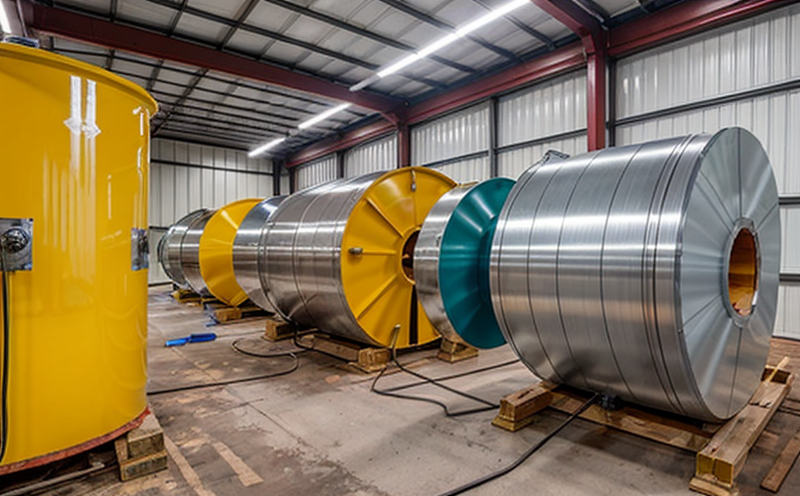ASTM G85 Modified Salt Fog Testing of Marine Paints
The ASTM G85 modified salt fog test is a crucial procedure used to evaluate the resistance of marine paints and coatings against corrosive environments. This testing method simulates the harsh conditions encountered by maritime equipment, ensuring that selected materials can withstand the rigors of long-term exposure. In the context of marine and ship equipment testing, this standardized protocol ensures high reliability and durability, which are paramount for safety and operational efficiency in the shipping industry.
The test is particularly important because it helps manufacturers identify potential weaknesses in their products before they reach the market. By subjecting paints to controlled salt fog conditions, engineers can observe how various coatings perform under simulated real-world conditions that include humidity, temperature fluctuations, and corrosive elements like chloride ions present in seawater.
The ASTM G85 test consists of several stages where specimens are exposed for defined periods while being subjected to specific environmental parameters. These parameters closely mimic the challenging environment faced by marine equipment. The testing process involves careful preparation of samples, which must be representative of the paints intended for use on ships and other maritime structures.
The primary goal is to assess not only the initial adhesion but also long-term durability after exposure to salt fog. This assessment includes checking for any signs of blistering, cracking, flaking, or loss of adhesion over time. Understanding these performance metrics allows manufacturers to improve their formulations and processes, leading to more robust and reliable products.
Compliance with ASTM G85 is essential not only for quality assurance but also due to regulatory requirements imposed by maritime authorities worldwide. This standard helps ensure that all marine paints meet the necessary criteria for use in high-risk environments where even minor failures could lead to catastrophic consequences, such as structural integrity issues or increased maintenance costs.
By leveraging this testing methodology, companies can gain a competitive edge by demonstrating their commitment to safety and quality standards. The results of ASTM G85 tests provide valuable insights into the performance characteristics of different paints under various conditions, helping decision-makers choose the most suitable products for specific applications within the maritime sector.
Applied Standards
| Standard | Description |
|---|---|
| ASTM G85-19 | This standard specifies the procedure for performing a modified salt fog test to evaluate the resistance of coatings and paints used on marine equipment. It includes detailed instructions regarding specimen preparation, exposure conditions, and evaluation criteria. |
| ISO 12944:2015 | This international standard provides guidelines for the protection of steel structures against corrosion in maritime environments. It covers various aspects including selection of protective coatings based on environmental exposure conditions. |
| EN ISO 17863-1:2014 | This European standard sets out requirements and recommendations for testing anti-corrosive performance of coatings applied to metal substrates under specific salt spray conditions similar to those found in coastal regions. |
The combination of these standards ensures comprehensive evaluation of marine paints, covering both the immediate impact during exposure as well as long-term durability. Adherence to such rigorous testing protocols enhances trustworthiness and reliability among stakeholders involved in maritime operations.
Competitive Advantage and Market Impact
The successful completion of ASTM G85 modified salt fog tests provides several competitive advantages for manufacturers operating within the marine sector. Firstly, it enhances product reputation by showcasing robustness against harsh environmental conditions, thereby attracting more customers from industries reliant on maritime infrastructure.
Secondly, compliance with recognized standards like ASTM G85 helps businesses meet regulatory requirements set forth by various national and international bodies overseeing maritime activities. This compliance fosters a sense of security among clients who need assurance about the safety and longevity of their assets.
Moreover, successful outcomes from these tests can lead to increased market share as competitors may be unable to achieve similar levels of performance due to lack of expertise or resources needed for proper testing facilities. Additionally, companies achieving top scores in such evaluations often find themselves at an advantage when bidding on major contracts requiring stringent quality assurance measures.
Lastly, the ability to consistently pass ASTM G85 tests demonstrates a company's commitment to excellence and innovation in developing advanced coatings solutions specifically tailored towards marine environments. Such dedication not only improves internal processes but also sets new benchmarks for industry performance standards.
Use Cases and Application Examples
The ASTM G85 modified salt fog test plays a vital role in ensuring the quality of materials used across various maritime applications. For instance, it is widely employed during product development stages to identify potential issues early on before full-scale manufacturing begins.
In this context, engineers can experiment with different formulations or combinations of pigments and binders without risking significant financial losses associated with large-scale production failures. Once identified problems are resolved through iterative adjustments based on test results, companies can proceed confidently into mass production knowing that their final products will stand up to rigorous testing.
A second important application is during quality control processes implemented at the factory level. Here, ongoing monitoring ensures consistency in batch-to-batch variations while maintaining high standards throughout the supply chain. Regular sampling and analysis using ASTM G85 procedures guarantee adherence to specified performance levels required by both internal specifications as well as external regulatory frameworks.
Another practical use case involves field inspections conducted after installation of new equipment on ships or other floating structures. By comparing current coating conditions against baseline data collected prior to deployment, experts can pinpoint areas requiring immediate attention or preventive maintenance measures before they escalate into bigger problems. This proactive approach helps extend the lifespan of assets while minimizing downtime and associated costs.
Furthermore, this testing method serves as a valuable tool during material selection exercises undertaken by procurement departments responsible for sourcing appropriate paints and coatings suitable for specific projects. Leveraging ASTM G85 results allows them to make informed decisions about which suppliers offer superior products aligned with project requirements.





